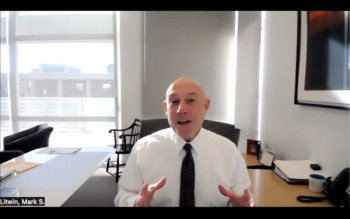
It’s urologists’ turn to do something about opioids
"As surgeons, our first step toward improving the situation is to become significantly better at controlling postoperative pain using opioid-sparing protocols," writes Henry Rosevear, MD.
Dr. Rosevear is a urologist in community practice in Colorado Springs, CO. Urology Times blogs present opinions, advice, and news from urologists and other urology professionals. Opinions expressed by bloggers are their own, and do not necessarily reflect the views of Urology Times or its parent company, MultiMedia Healthcare.
It is rare that a single lecture radically alters my practice. I’ve been on my own long enough to have developed some habits (good and bad), and more importantly I know what works for me. As a result, it surprised me and the people I work with when I came home after hearing Dr. Nicole Miller’s Rocky Mountain Urological Society talk on the opioid crisis and changed how I use narcotics.
This message was reinforced at the AUA annual meeting and is the single most important message I took home from Chicago.
That there is an opioid crisis in America is not be a surprise. It is truly an American problem, with Americans accounting for
Further, I knew that opioid deaths are increasing (47,600 deaths in 2017 alone), but I didn’t understand the context of that until I realized that
Also by Dr. Rosevear: Do reimbursement trends signal another Dr. Lupron moment?
Where do people get the vast majority of their opioids? From us.
What can we do? This may be simplistic, but for the most part we need to follow Nancy Reagan’s advice from many years ago and “just say no” to prescribing narcotics. I am in no way advocating that we not treat our patients’ pain; I understand that surgery hurts. What I am advocating is that we do it in a smart and proactive manner to limit both the quantity and duration of the narcotics we use.
Yes, the quantity and duration of opioids that we prescribe matters greatly. What do the data say? Let’s look at quantity first and start with how I used to write for pain meds. Up until recently, after surgery I would routinely write for oxycodone/acetaminophen 5/325, one to two tabs q 4 hrs PRN, dispense 30, no refills. That is approximately 90 morphine equivalents a day.
Why is that a problem? Studies by Dunn (
Now consider duration of use. A study by Shat et al in 2017 showed that the 3-year probability of chronic use was approximately 5% for a 1-week opioid prescription but almost 20% for a 30-day prescription (
Next:
On discharge, patients receive oxybutynin, tamsulosin, and scheduled ibuprofren and acetaminophen. Interestingly, Dr. Miller stressed that she wrote out prescriptions for both ibuprofren and acetaminophen and gave those scripts to her patients, as there is something almost magical about getting a prescription versus going to Walmart and buying medication off the shelf. Her protocol worked: She found no difference between her standard narcotic group and her no-opioid group in postoperative patient phone calls, requests for more pain medicines, or emergency room visits. This truly is amazing, and if I may be so bold, I would argue that we all need to start implementing strategies like this today.
My second example is for the critics who say this may work for surgeons who do “little” cases, but for those who make real incisions, we need real medicine. Actually, you don’t. You just need to be creative with your regional blocks. Drs. Anthony Anderson and Francis McGovern presented amazing work on the use of creative regional blocks in their AUA instructional course,
Read -
We’re not the only people thinking about this. While the federal government has yet to take any meaningful steps, many states have legislation in place. As of this year, almost two dozen states have passed laws setting restrictions on the quantity and/or duration of opioid prescriptions. Interestingly, one of the toughest is in Tennessee, Dr. Miller’s home state, where there is a 3-day, 60-morphine equivalent limit in most opioid-naïve patients (see,
If truly implemented, think about how this would change our daily lives. Thirty-year old man walks into the ER with nausea, vomiting, and 10/10 right flank pain. CT shows a 5-mm mid-ureteral stone. No fever and no evidence of infection. ER gets his pain controlled with IV morphine. Now what? Current management is to send him home with pain medicine and medical expulsive therapy with outpatient urologic follow-up. In my world, I usually would have given him 3-4 weeks to pass the stone before intervening.
Is that appropriate if he needs opioids during that 3-4 weeks? How does the risk of immediate surgical intervention weigh against his risk of chronic opioid use if he needs a month worth of opioids to pass the stone on his own? I don’t know the answer to that one, but if we start early intervention on most stone patients, that’s going to mean even more late nights in the OR.
Unfortunately, in the short term, things will likely get worse before they get better. The data is pretty clear that as prescription opioids are withdrawn, a certain fraction of patients will move to street drugs such as heroin and fentanyl. But this tide will pass and things will get better. As surgeons, our first step toward improving the situation is to become significantly better at controlling postoperative pain using opioid-sparing protocols.
Newsletter
Stay current with the latest urology news and practice-changing insights — sign up now for the essential updates every urologist needs.


















